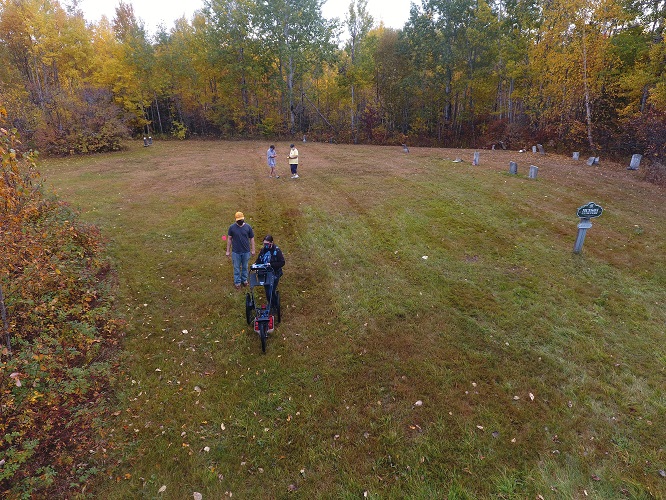The cemeteries in central Aroostook County hold a treasure trove of stories and Dr. Kimberly Sebold, Professor of History at the University of Maine at Presque Isle, has received a $6,000 Maine Humanities Council Major Grant to find them and turn them into history lessons accessible for local students and history buffs alike.
Sebold’s project, History in Stones: Mapping Cemeteries to Teach the History of Central Aroostook County, accomplishes two major goals. It’s the first all-encompassing attempt at scholarly work to capture the history of central Aroostook County, and it establishes a comprehensive local history curriculum for 8th graders studying Maine history.
“This is important work. In terms of scholarship, there has not been much done in central and southern Aroostook. There’s been work done on lumbering and Acadian culture, but the only thing I can point to that would be comprehensive is the old histories that were written at the turn of the century—and they were written by storytellers, not professional historians,” Sebold explained. “I think it’s time that this history was told.”
The grant work involves updating Sebold’s existing Aroostook County History website. Local company Mouse Island Creatives will complete that work. The website, which will address the Maine State Learning Results for social studies and English language arts, will include scholarly articles on the history of the region, cemetery maps and cemetery stone photographs, social studies lesson plans, as well as about 15-20 story map journals that social studies teachers can use when completing the Maine History curriculum that must be taught to 8th graders throughout the state.
These journals use a tool called ArcGIS online—school systems can access it for free—that makes history interactive and engaging. The story map journals will cover many aspects of local history: Micmac culture, early settlements, the Aroostook War, the immigrant experience, agriculture, folklore, entertainment and sports, industry and transportation, and the history of the air base/airport in Presque Isle.
Helping Sebold to write the journals and lesson plans are local historian Dr. Dena Winslow; three local educators—William Guerrette at Presque Isle Middle School, Deb Davis at Fort Fairfield Middle/High School, and Anthony Scott at the Maine School of Science and Mathematics; three UMPI Online History majors—Angela Wilkinson, Krista Luttrell, and Rogue Reeves; and workstudy student Hannah Rachel Brewer.
Dovetailing this work, Sebold has also received a Zillman Family Professorship, which she is using to map the region’s cemeteries with GPS units and collect the information that appears on each gravestone and marker. There are at least 50 cemeteries in central Arooostook—from Caribou in the north to Blaine in the south, and from Mapleton in the west to Fort Fairfield in the east—ranging from large cemeteries to small family plots. With the help of local volunteer Marlene McEachern, Sebold was able to map and collect information at about 25 cemeteries last summer. Through her professorship funds, more cemeteries will be mapped this summer.
“Cemeteries can help teach history by focusing on the people in them and explaining how local, state and national events impacted them. In addition, there is a desperate need to document small family cemeteries—they’re being destroyed by the elements and when there are no family members left to care for them, they return to nature. The loss of these small cemeteries amounts to the loss of history,” Sebold said.
To help, Sebold’s project will archive these cemeteries and their stones for future generations, and research the information on the stones to find and tell important local stories. For example, in the Lovely Cemetery in Fort Fairfield, there is a Benny Robinson who passed away in 1921. He was an African-American farm laborer who owned land. The team is trying to track down family members who would be able to help them tell his story.
“It’s important we capture the history,” Sebold said. “I like public history; it’s history for local people. This is probably my last 10 years of teaching and I wanted to go out with a bang. That’s what prompted me to do this work and do it in a way that the community could enjoy the work as much as those interested in the scholarly work.”
